How to Cook Tender Beef Tongue – The Easy Way
This post may contain affiliate links. Read my full disclosure here.
Cow tongue, beef tongue, ox tongue – no matter what you call it, learning how to cook beef tongue may seem intimidating, but it’s surprisingly easy to do.

The simple cooking method that I like to use creates a tender, delicious cut of meat that can be served like a roast or sliced thin and used cold for sandwiches. Since we buy our beef in bulk from a local friend who raises grass-fed beef, it’s important for us to be able to use up all the organ meats.
How to Cook Beef Tongue – Step by Step with Photos
The first time I cooked beef tongue, I had some help from my big sister, Lois. After all, what are big sisters for if not to help you eat strange things? When we pulled the tongue out of the freezer, it looked like this.
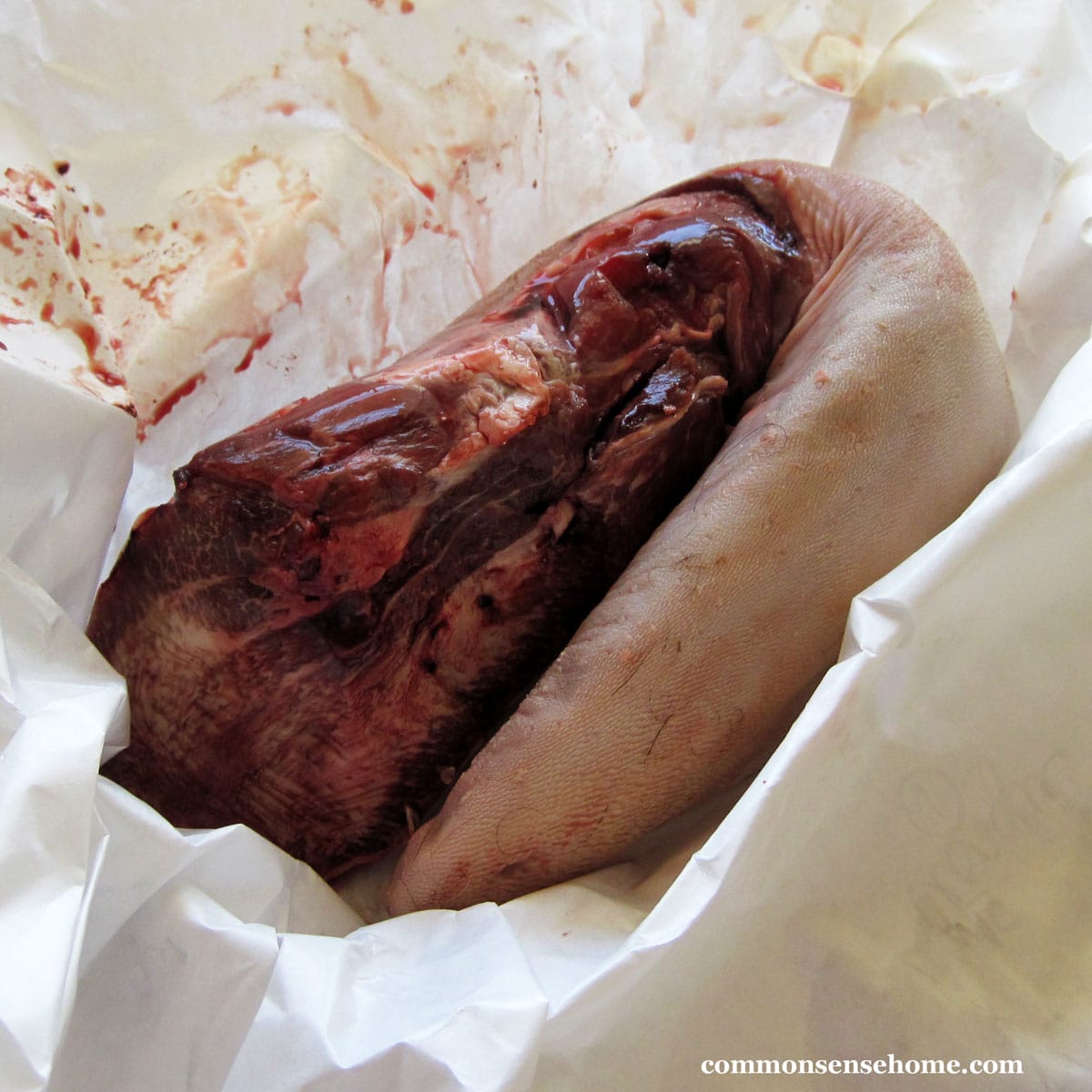
Cooking beef tongue couldn’t be much more straightforward. The tongue doesn’t have bones or connective tissue to deal with like other cuts. Mom always simmered it on the stove when we were kids, so that’s what we did, too.
Just put it in a kettle or Dutch oven with about an inch of water over the top, and add plenty of aromatics – garlic scapes, onions, bay leaves, salt, pepper, and some celery.
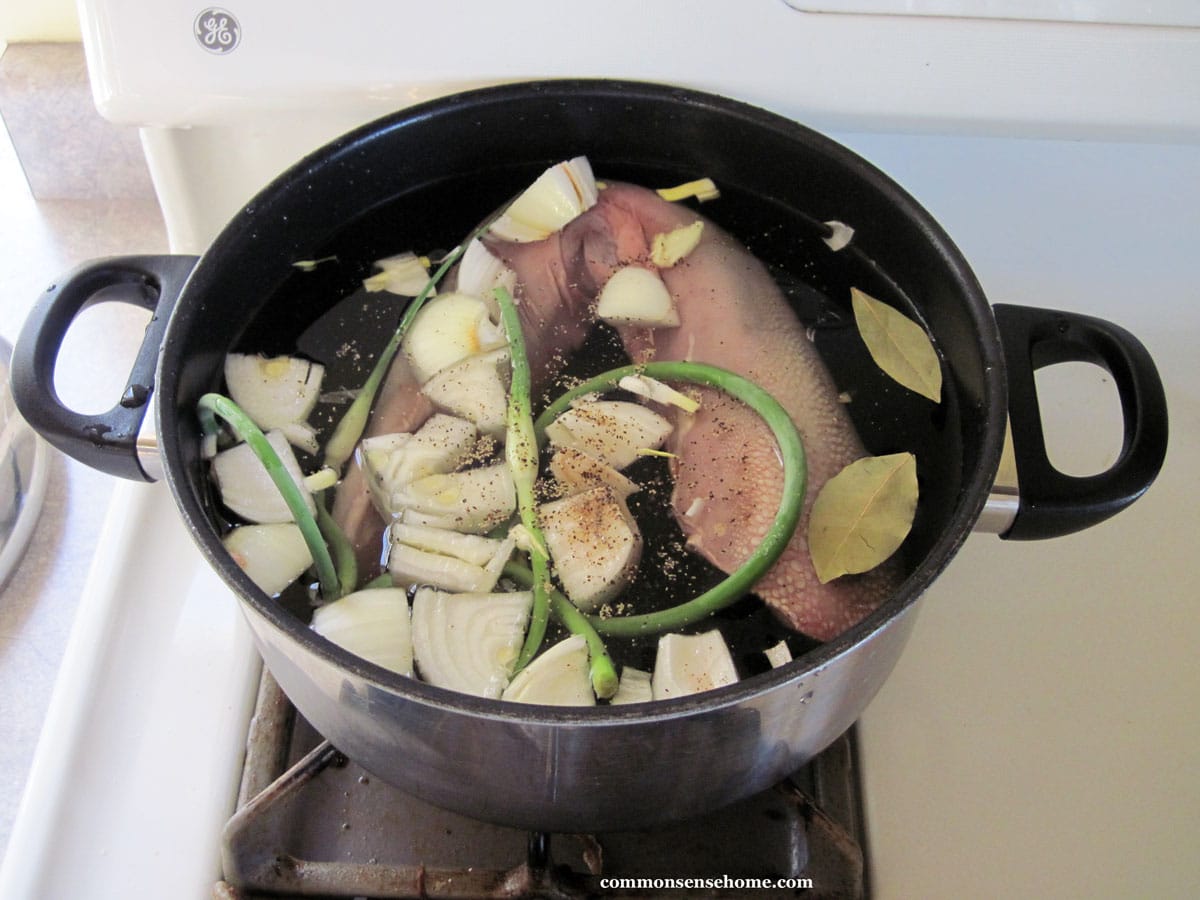
Cover and simmer for 2-3 hours. When it finishes cooking, place the cooked tongue in an ice water bath to chill it enough to handle.
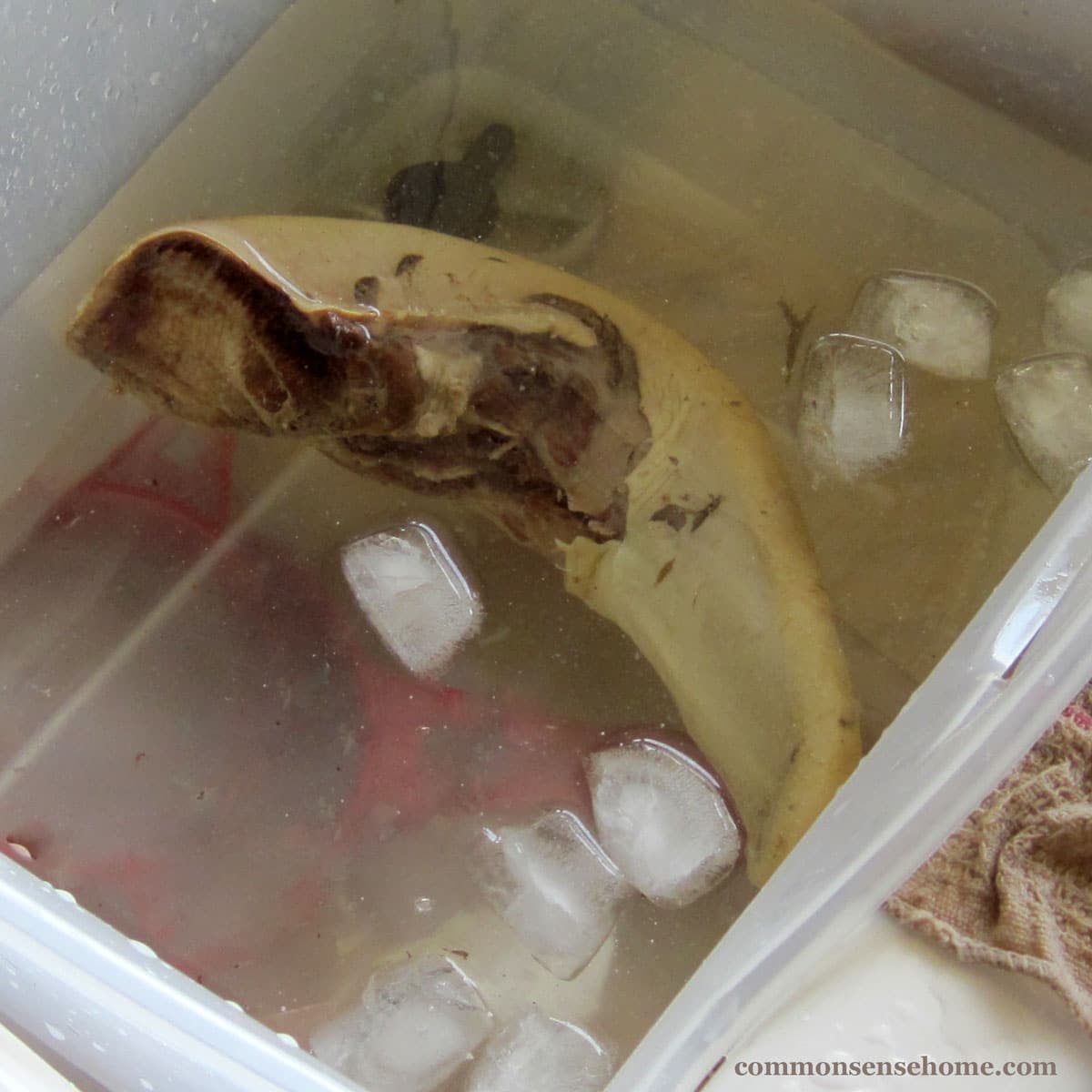
Once you can handle the tongue, peel off the skin. Don’t let the meat cool too much, as the skin will stick. Trim with a small knife as needed.

Now you have an excellent piece of meat.
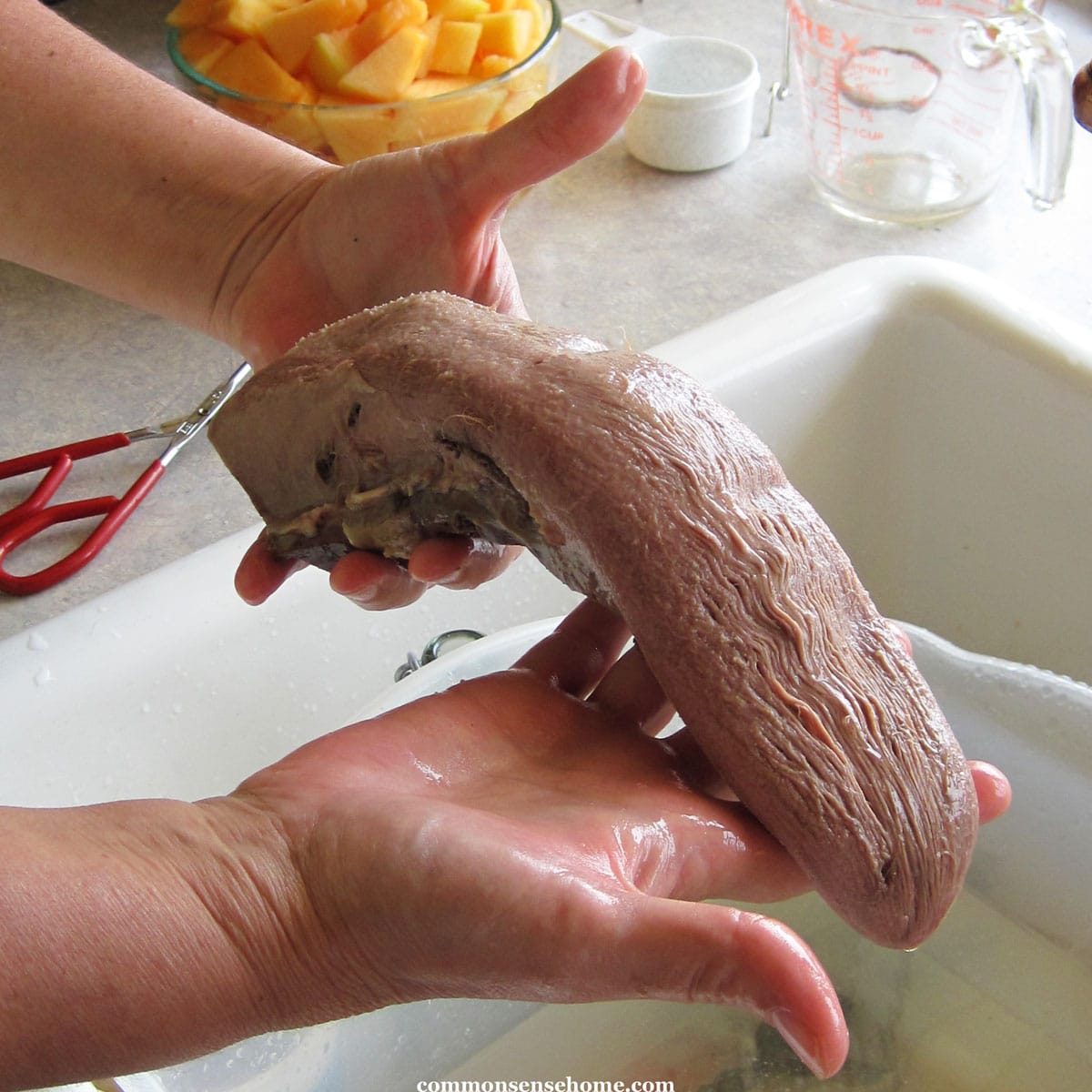
Slice thinly and serve with your choice of condiments. My brother Rich suggests horseradish. Get a recipe for homemade horseradish sauce here.
Would you like to save this?
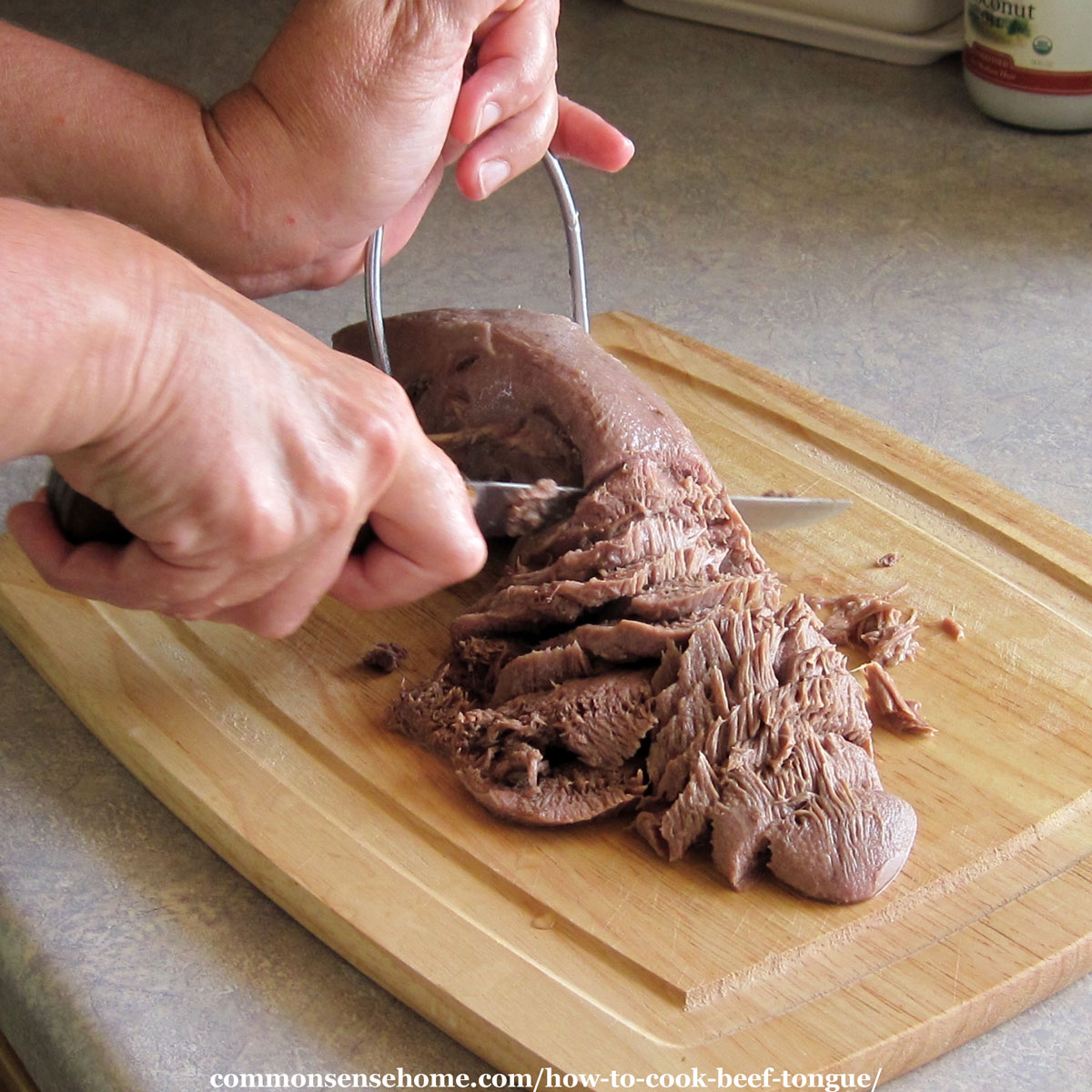
It’s very tender and delicious. It melts in your mouth. The boys couldn’t tell it wasn’t a “regular” roast. I find it more tender than a regular rump roast.
Cooking Beef Tongue in a Pressure Cooker (or Instant Pot)
One of our readers shared their preferred beef tongue cooking option – the pressure cooker.
“Forget the simmering for 3-4 hours. Just pop the tongue in a pressure cooker with water to cover, salt, and ginger slices. Cook for 45 minutes for a 2 pound tongue, 40 minutes for a 1 pound tongue. It comes out perfect without the wait and uncertainty.”
Whether you choose the stove top or a pressure cooker, enjoy this rich cut of meat.
PrintBeef Tongue Recipe
Slow simmered with aromatic spices, this easy beef tongue recipe can be served hot or cold.
- Prep Time: 5 minutes
- Cook Time: 3 hours
- Total Time: 3 hours 5 minutes
- Yield: 12 servings 1x
- Category: main dish
Ingredients
- cow tongue (normally around 3 pounds or 1.3kg)
- seasoning- 1 onion, 3 cloves garlic or garlic scapes (or more), 3-4 bay leaves, celery, salt and pepper to taste, or other spices of your choice
Instructions
- Wash the cow tongue.
- Place the tongue in a large stock pot or Dutch oven with the seasonings and enough water to cover.
- Cover and simmer the cow tongue for 2-3 hours (cook time).
- Chill the tongue in an ice bath until just cool enough to handle and peel immediately.
- Slice and serve hot or chill and serve cold.
Notes
Refrigerate leftovers in an airtight container and use within 2-3 days, or freeze for longer storage.
For pressure cooking: Pop the tongue in a pressure cooker with water to cover, salt, and ginger slices. Cook for 45 minutes for a 2 pound tongue, 40 minutes for a 1 pound tongue.
How to use Beef Tongue?
Use cow tongue like any roast beef: straight with gravy and potatoes, in Chinese and Mexican dishes, topping for salads, casserole, stew, or as an excellent roast beef sandwich. Pair it with some salsa verde in lengua tacos!
Cow Tongue FAQs
What is cow tongue called?
Beef tongue is known as “lengua” in Spanish, “langue de boeuf,” in French, and “lingua di manzo” in Italian. Whatever you call it, its tender and flavorful qualities make it a favorite ingredient in various global culinary traditions.
Is beef tongue healthy to eat?
Beef tongue or cow tongue is a nutritious meat choice and can be a healthy addition to your diet. It is relatively lean and provides essential nutrients. Here’s some nutritional information for beef tongue per 3-ounce (85-gram) cooked serving:
- Calories: Approximately 150 calories
- Protein: About 19 grams
- Fat: Around 8 grams
- Cholesterol: Approximately 70 milligrams
- Iron: Provides a significant amount of iron, an essential mineral for red blood cell production.
- Zinc: Contains zinc, which is vital for the immune system and overall health.
- Vitamin B12: Rich in vitamin B12, which is important for nerve function and energy production.
- Other B Vitamins: It also provides other B vitamins, like niacin and riboflavin.
It’s important to note that the exact nutritional content varies depending on preparation and any additional ingredients used in the dish. Overall, beef tongue is a good source of high-quality protein and several essential nutrients.
What does cow tongue taste like?
Beef tongue or cow tongue has a distinctive flavor and texture. When properly cooked, it is tender and quite flavorful. The taste of beef tongue is often described as rich, beefy, and slightly sweet. You can crisp the texture up by sauteing it in a pan with oil or fat.
Whether it’s stewed, grilled, or cooked in an Instant Pot, tongue adds a unique element to any meal. Proper cooking and seasoning are vital in bringing out the best in beef tongue and ensuring it is tender and delicious.
Do you peel a beef tongue before you cook it?
You definitely want to peel the tongue before serving, but I find it easiest to do right after cooking. The outer layer of the tongue is the “skin” or “membrane”. The skin can be tough and not very palatable, so peeling it is an essential step to make the meat more tender and enjoyable.
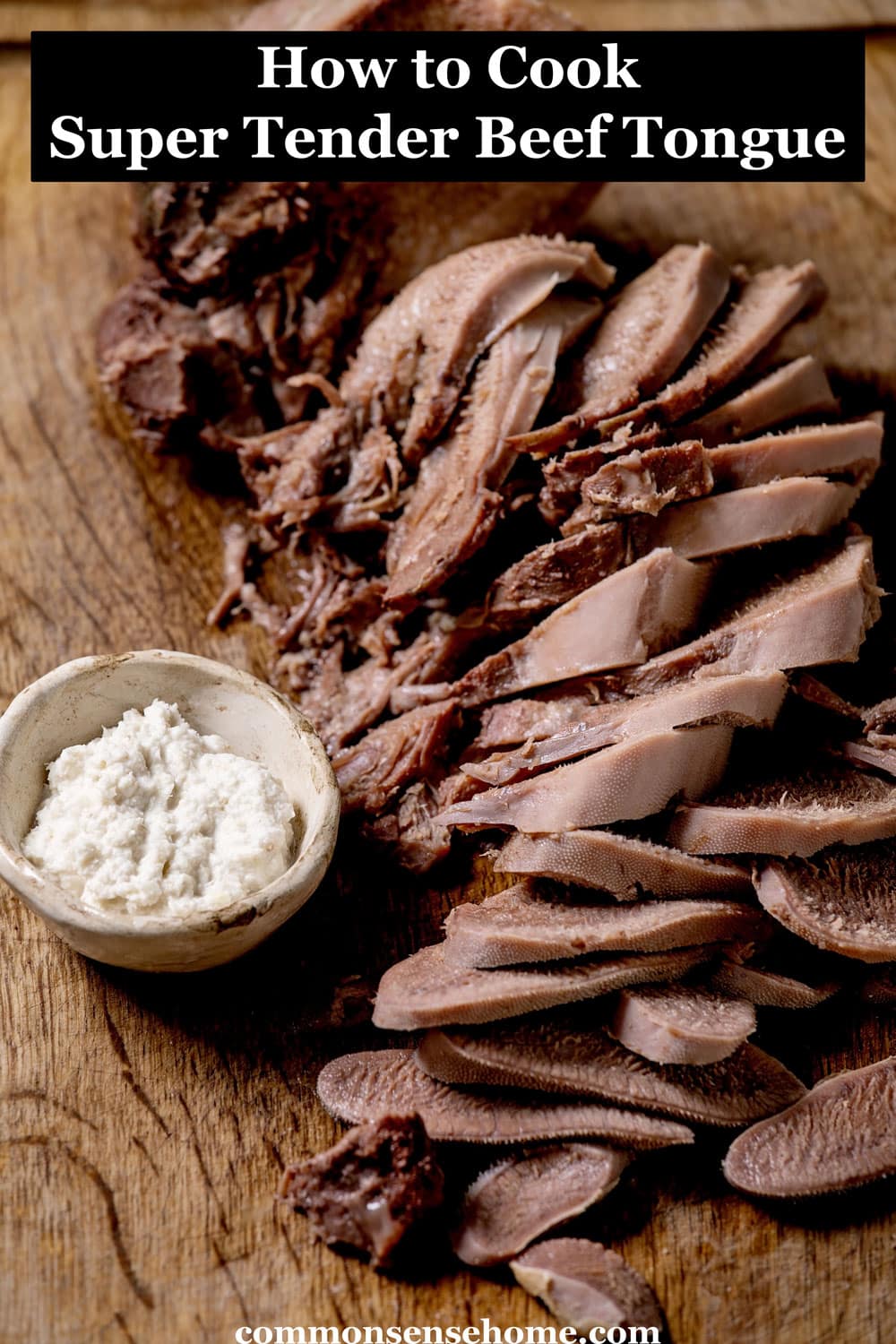
More Easy Homestyle Recipes
- Easy Homemade Alfredo Sauce – Great for Chicken Broccoli Alfredo
- Church Dinner Chicken
- Beef Stock Recipe – How to Make Stock from Scratch
- Budget Friendly Ground Beef Jerky Recipe
- Chicken Pot Pie

This article is written by Laurie Neverman. Laurie grew up in the kitchen, learning baking and home cooking from her momma. At age 15, she and her mom and two sisters created Irene’s Custom Cakes & Catering, which was her summer job through most of high school and college.
Originally published in 2011, last updated in 2024.

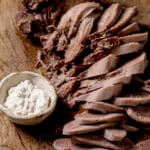
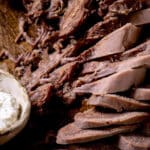


![Odd Bits: How to Cook the Rest of the Animal [A Cookbook]](https://m.media-amazon.com/images/I/51OHG6-B8pL._SL160_.jpg)
A little joke for your perusal: I asked my friend if he would like a tongue sandwich and he replied “ Oh my! I could never eat something that came from a cow’s mouth …. I’ll have an egg sandwich please”.
Some people are very selectively squeamish.
Oh my, too funny! 😉
Just bought 3 cow tongues at the locker. I put one in the crock pot for 5 hours. It is better than $25 a lb. ribeye. Stretch that food dollar. Great with noodles and can of mushroom soup.
Another option is to have it ground up with the hamburger meat. This makes it less intimidating. 👍
great info on an overlooked cut!
great recipe
We had cow tongue a fair amount when I was growing up, but I have never been brave enough to try it myself. Thanks for explaining so thoroughly how to do it!!
Wonderful Recipe!
Hello, I’m the staff of the Korean broadcasting program [After School Korea School Trip]. In our program, a story about cow’s tongue food came out. Therefore, I want to use the cow tongue picture you posted on the site as a data screen, so I am leaving a comment. We will leave a source when we use the picture. The source will remain [Source – COMMON SENSE HOME]. Is it okay if we use the picture?
Yes, please include credit and a link back to the source article. Thank you.
My mom and myself cooked it the same as your recipe but when it was done she sprinkled Hungarian paprika on it and fried it in a pan for a few minutes on each side.
My kids also love all kind of meats.
Liver, brains, sweet breads, mountain oysters, tripe, etc. Too bad Americans are missing out on this delicious foods.
My mom used to say, “People don’t know what’s good.” Too many people have gotten used to a narrow range of foods (often highly processed) and they have a hard time eating anything else.
As a hunter, this is one part of the elk and deer I’ve never utilized. Plan on eating this in the field when I harvest my game. I do eat the heart and liver and testicles. Liver and testicles I fry. Heart I like pickled, made into jerky, fried or a Moroccan style heart stew. All so yummy! Thanks for sharing this. Definitely a harvest night treat in the back country!
I had a Mexican friend tell me if the tongue is cooked long and slow, it won’t need peeled? Is this true?
If you’re hungry enough you can eat just about anything. The skin (well cooked) certainly wouldn’t kill you. The skin on the tongue has been in contact with everything the animal licked, from food to backside, but it gets washed and sterilized during cooking.
I peel because of the texture of the skin. Even after long cooking, it tends to be rubbery. It’s a bit like a pair of rubber galoshes that fit over the tongue.
I’m an old lady who has raised animals all her life and we ate any we wanted including wild game. Dad was careful to be sure it was properly dressed and stored but we ate all the animal. I no longer save the brains and sweetmeats but all the rest can be very tasty. Liver and kidneys need to be soaked in milk a few hours to lessen the bitter taste. Wild game often benefits from this too. The gelatin “stuff” that holds meats and vegetables together in a loaf for slicing is made from long boiling of bones with gristle on the ends–most of the long bones and the ox tail. Not a lot of meat on the tail but cut into joints it can make a wonderful gelled sandwich meat or stew. And congratulations on using chicken feet for broth. The need to have the toe nails cut off and the skin removed after scalding them then washed and cooked for broth. Such broth is so very rich and flavorful.
Waste not, want not. Broth made with bone and cartilage is full of nutrition.
We skin the feet and peel off the nail coverings rather than cutting off the tips, so nothing that was in contact with chicken poop remains.
I grew up eating cow tongue and never thought anything of it. It’s delicious without anything but some salt. I have one in the freezer and can’t wait to make it. My husband had it and liked it as well even though he never had had it before.
I live in Texas.Mexicans call it lingua and it is great on tacos!My husband who swore he would never eat it (cuz he could tell the difference and it would make him sick)has been eating them and commenting on how tender the “roast” is for about 9 of our 20 years of marriage????The secret I found is slicing it and never letting him see me cook it.Delicious!
There you go. My mother-in-law hasn’t wanted to eat my soup since she found out I use chicken feet to make the stock, but she says as long as she doesn’t see them, she’s okay.
My favourite meal int he whole world that I can remember from a very young age is Ox Tongue in Sherry Sauce.
This was cooked by my grandmother’s chef Harry Patterson at the Cape Turf Club and he had it down to a T simply delicious.
Although the sauce was called Sherry sauce it was cooked in the conventional way to start in boiling water with bay leaves, onions, carrots – usual stockpot with salt and peppercorns but the it was placed in this sherry sauce which was oinionsm tomoattoes and green peppers cooked down in Demi glaze with white wine until everything was infused into each other. The tongue was then sliced and this naturally thickened sauce spooned over. Served with Mash and veg on the side. The best.
I have tried to replicate this at home but don’t have a restaurant stock pot or deglazed pans so can’t seem to get the original flavour that I remember. If only he was still alive.
Your story reminds me of my sister, talking about my grandmother’s special chicken soup.
How would I make the cooked Tongue into pressed Tongue with the jelly in and around it? I love Lunch Tongue that you buy in the Supermarkets and would love to try and recreate myself. I think the jelly is made using some of the stock and gelatine, do you have any suggestions that might help me? Thank you
I’ve never purchased pressed tongue, but from a little digging around on the internet, it looks like the beef tongue is cooked as directed, and then while it’s still warm, it’s pressed tightly into a loaf pan. The pan is covered with a weighted plate, and then the whole thing is left to chill for around half a day. The gelatin is formed from the natural juices that are in the tongue as they chill.
I had a beef tongue in my freezer, and after reading your recipe got the nerve to try it out. It’s cooking as I type! I’m not going to tell my husband what he is eating till after consumption! Sure hope it turns out as good I’ve heard it can be.
Good luck!
Me and my daughter’s love it, especially the back part. The front makes great sandwiches. I Hook it, peel it and hen add veggies and tomato sauce and let it cool for an hour. Great meal. Lamb tongue cook in sauce till tender, peel add veggies, potatoes carrots onions let it simmer.
Thanks for this blog post. I’ve had a couple of beef tongues from a couple of years of shared cow quarters intimidating me in my freezer. After reading this it seemed easy enough to try. Turned out great, We will make tacos and I’ll never be afraid of cooking tongue again.
Tongue is a strange looking piece of meat, but I find cooking it easier than some other cuts, especially for grassfed beef.
Just boil it for 3-4 hours then remove from water, slice, then simmer in bbq sauce. With a side of mashed patatoes is the best.
I forgot to say that you needed to peel the skin while it’s hot before slicing.
I remember my mom cooking tongue in the 1960’s for sandwiches. It was good so I tried it again, cooking it for 3 hours. After peeling off the skin, it appears I might be able to use it like pulled pork. Add a bit of Bear’s Head ketchup, place it between some speciality buns, add an onion slice, and voila. What about the broth…strain it of the aromatics, let sit overnight in the pan, skim off and discard the fat, pour into freezer containers for later soup use?
You certainly could reuse the broth if you like. I usually go for bone broth over meat broth because of the gelatin and other nutrients.
The last time I cooked up a tongue, the boys were so hungry that they ate almost all of it in one sitting.
Smoked tongue is really tasty!!
Hello! It was so hard to peel the skin. I’m using a pot and heating on gas stove. Do you need to cook 2 to 3 hours? If you cook it longer will it easy to peel with your hands? Thanks.
Longer cooking may make it more difficult to peel. I’d suspect the different layers would become even more cooked together. If it doesn’t peel easily for whatever reason (the skin comes off the easiest when it’s almost too hot to handle), carefully trim it away with a knife. You’ll lose a bit of the tongue meat, but if you’re careful, you shouldn’t lose too much, and it may be easier than peeling if the tongue doesn’t cooperate.
I cooked it in the IPot, skin on 1hour 45 min. Just like mom cooked it on her stove.
It peeled easily, very tender and moist sliced easily. Made tacos with Mexican cheese, toco sauce on corn.
3lbs 1 hour 45 min natural pressure release till I could turn the lid.
I inserted garlic into the meat, Polk a holes. Onion powder, celery. Some like horseradish on their tacos.
Thanks, Mary.
Hello! I am getting ready to cook tongue for the first time ever. I’ve heard that it can be slow-cooked in a crockpot, so I’d like to try that. My question is this: How long would I have to slow-cook it for if set on “low” heat? Also, would I still need to cover the tongue in water completely in a crockpot… or should I use less liquid? If so, how much liquid?
Thanks
Put it in the crock pot with the seasonings and add enough water to cover it. Cook on low for eight hours, proceed with the rest of the recipe (peeling, etc.).
Thanks! It came out awesome! I hear that a lot of people fight over the tip, but I actually think the best part is in the weird looking section at the base of the tongue where all the fatty connective tissue is.
Thanks for letting me know how it turned out, and I’m glad that it worked well. I like all of it, as long as it’s shaved thin, because the meat is so rich.
I really enjoyed reading these TONGUE comments all the way back through the months/years. I grew up with it and then as an adult haven’t cooked it for years. I started ordering meats that are grass fed and decided to try tongue from them. I cook it in the pressure cooker with salt & pepper AND garlic is a must. This last one was hard to peel. I use the broth for soup with onions, parsley and barley added. I feel so much better knowing I am not weird because I like and eat beef tongue.
You are definitely not alone.
i love tongue. I had bought a small one and boiled it for about an hour. I will make a garlic, parsley and oil sauce to go over it. I cannot wait.
I’m going for it. Filling the pot with water as I type!
Woot! We just picked up another half of beef from the processor last week, and the friend we purchased it from sent in two animals and the people who purchased the other critter didn’t want their tongue, so I’ll be doing the same soon.
Does beef tongue sometimes not peel easily? Mine has been in the slow cooker for most of the day and I had to slice off the skin. It wouldn’t pull off at all.
Sometimes, yes, the tongue doesn’t peel easily and I’ve had to slice off the skin. The best way to get it off is to remove it as soon as absolutely possible, while the meat is still piping hot. Harder on the fingers, but easier to peel. Kitchen gloves may be helpful.
I finally decided to pull out the TWO beef tongues I’ve had languishing in the freezer. They are cooking and I’m trying to decide if I should tell the family what I’ll be feeding them… 🙂 Thanks for such easy instructions!
You’re welcome! If they’re squeamish, don’t tell them until after. 😉
That’s my philosophy as a well, traveled individual: eat it and then ask what it is, lol…
My mom used to make a sour cherry sauce over tongue, and I’ve spent years being frustrated that I didn’t get the recipe! I think it involved a can of cherry pie filling, but other than that, no idea.
Hmmm…allrecipes dot com has a pork chop recipe that is nothing but the pork chops slow cooked with cherry pie filling? I wonder if your mom did the same thing with tongue?
Boy, it doesn’t get any simpler! Put the cherries in, put the pork on top, cook. That’s my kind of recipe! Thanks Laurie! I’ll try that.
You’re welcome.
I had a in-law tell me that she wouldn’t eat anything that came out of an animal’s mouth ! My wife’s answer, well we have some eggs for you .
The other end is much better. 😉
I love beef tongue, its my favorite part of the cow!! Grew up eating it whenever we butchered. My Mom used to pickle it. I like it just boiled and sliced.Thanks for all the ideas!!!!
You’re welcome. Tongue, liver, heart, tail – nothing was wasted. My brother made some oxtail soup while he was here. It was also delicious.
I put cooked tongue slices (~ 1/4″ thick) in cream of undiluted mushroom soup to reheat for about 15-20 min, then serve with wide egg noodles, green vegie & salad… Don’t overcook it when reheating or it becomes rubbery & tough…
Thanks for sharing.
This Will be my first time cooking a beef tongue but, my mom use to make it & it was better serve cold/cool. I hope i can fix it right, i am going to cook it for three hours to make sure it’s done. Lonnie Alexander
I love beef tongue! I slow cook it overnight covered in water then when cool enough I peel the skin off and eat with roast veggies or sauteed veggies in bone broth. So good! I hate it when it’s still kind of firm, super soft is my preference!
I hope more people start eating quality beef offal for all the health benefits 🙂
Tongue makes excellent tacos!
I made this a few years ago and again today. It’s amazing how the meat is so tender and no visible fat! It’s great with kugel and a salad. It’s very Delicious
I find that a pressure cooker cooks a tongue in less than an hour. I set my timer for 45 min.
Growing up on the farm we ate everything. Dad used to say that the only thing we didn’t use from a pig was the “oink”. I have eaten tongue several ways. Mom used to boil it, peel it, slice it and put it on a cookiesheet with some salt, onion powder& garlic powder . Roast it for about 30 or so minutes. I like it sliced cold on bread with Mayo & lettuce. Mexican cuisine & the Greeks do a small dice and sautee it with onion, peppers, tomatoes & seasoings. Germans like it with a Ginger Snap sauce. A Tavern I used to frequent in Fallon, NV served it pickled. So many ways to enjoy tongue. In the Middle East, Kuwait, I ate Lamb tongue several times. Beef liver, sliced very thin is best if soaked overnight in milk, this removes all the blood that gives liver it’s unique flavor if no removed first. If you have a cat it will wait for you to fix liver it will just lap up the milk. Sautee sliced onions, remove when translucent, dredge the liver in seasoned flour and then brown in a little oil. Remove from pan and add some butter or oil anda bit of flour brown the flour season with salt & pepper to taste and slowly add some milk to form a gravy add the liver & the onions and cook until the liver is done. Do not over cook.
I learned to wash the sliced liver and dry coat liberally with prepared mustard and then flour coating and fried with onions and gravy..it doesn’t have that {taste like yuck} flavor my boys even liked it.
I grew up eating pickled cow’s tongue and loved it. My mother prepared it but I never saw what spices she used and she passed away young. We grew up eating a lot of Jewish ethnic food and tongue is a staple. It can still be found at some deli’s in towns with a larger Jewish population. I live near Pittsburgh and they still have a couple of places that sell it.
Rowan – I wonder if this is anything like your mom’s recipe?
http://jewishfood.wordpress.com/2009/10/12/pickled-beef-tongue/
Thanks for sharing your memories. 🙂
In n y c tongue is sold in all Dellies. Boiled and kept warm in a steamer. Its then sliced and used as a sandwich filling. Of course you must use sliced dark rye bread and mustard. Enjoy
I use the slow cooker over night with garlic. Then in morning I peel it and slice but place now in oven for half hour to an hr it gives it a different texture n its awesom
Nadia – thanks for sharing. I know a lot of folks love their slow cookers, especially in the summer.
Like Nancy – I pressure cook it, with spices, then peel etc. The tip of the tongue is such a delicacy the kids would fight over it 🙂
One thing not mentioned, once peeled, is to grind it up – large grind, then medium grind. Add miracle whip to it and some seasonings, salt – and use it like a deviled ham spread…or like tuna fish spread. With more miracle whip on bread, maybe a little mustard if you like the tang, this is a great sandwich spread 🙂
Sounds good. I might even be able to sneak it past my MIL like this. 😉
This is how my Mom prepared it… except she used real mayo. Yummy
Yes. Real mayo! I’ve never been a miracle whip kind of gal 😉
Leanna – that sounds good! The aromatics are a good idea to add flavor, as the meat itself can be somewhat bland.
Christina – you could make head cheese or kishka (pig’s head sausage with blood and barley). I haven’t tried making either at home, but I remember them from when I was a little girl. The book “The Whole Beast: Nose to Tail Eating” may be helpful as well.
Nancy – too funny that your husband is squeamish about peeling the tongue. Good thing he has you!
Tongue is a favorite at our house most likely because it is something of a rarity and there are quite a few of us to feed. more than 20 years ago, my dad taught me how to prepare it using a pressure cooker and it is so delicious and tender. These days while my husband knows how to prepare tongue (in case of some emergency where I was unavailable, lol) I still get called in to peel it; he still can’t get over that step! I have never had it boiled but I would imagine it is much the same. We use the broth to cook noodles or flavor mashed potatoes as well. If you manage to have any left, it is great the next day as a cold meat sandwich – we love it with Miracle Whip, lol.
This sounds wonderful! I remember eating tongue meat in sandwiches (in jelly and yummy). We are getting a pig from the butcher this coming weekend so if anyone has suggestions for a pig’s head, I’m all ears (haha)
Chris
My ex (from Mexico) loved tongue. I had never cooked it or eaten it until he asked me to cook it.. trust me I gave him a crazy look.. but he showed me how. In Mexico they eat tongue tacos.. very very good.. with a little cilantro, fresh onion and avocado!
Thanks for the tongue tips. 🙂 I have friends with goats and lamb, so I may have to see about trying those out when the time comes. We don't eat a lot of pork. None of us have ever really enjoyed the flavor, except in cured meats, but most of those have additives we try to avoid.
We had boiled tongue growing up, we loved it. A couple things we did differently: we poked some cloves into the tongue, and used the leftover juice from some dill pickle jars (probably 1:1 with water) and added pickling spices.
Serving after: I agree with your brother. Horseradish. Or mustard. Or horseradish mustard.
Since then I've had both goat and lamb tongue, excellent! Just cook it less long. I tried pig tongue but was totally unimpressed, it's very meal-y.
There are delis in New York City that sell tongue sandwiches, and we do have a local Mexican place that I believe makes tongue tacos, or some dish with tongue.
You're amazing. I've only eaten tongue once and it really was the most tender meat I've ever eaten. Not sure I'm ready to make it but when I am I'll come here to see how. Thank you for sharing this on Real Food Weekly!
A Mexican place here in town sells beef tongue tacos. I haven't tried them yet, but it's on my list of things to eat.
The tongue is ridicliously priced here! Like 12.00 for an cleaned one and 10 for an uncleaned one. I mean, I can get a beef roast for that price.
lol, Audrey. I was a little freaked out when I tried this, too, but I found the tongue to be much tastier than liver. (Although good liver is much better than bad liver. I'll have to post about the "grade D but edible" stuff they fed us back in college at some point.) Really, truly, it tasted like a very tender roast when it was done.
OMG. Okay, I've recently jumped on the liver band wagon (I NEVER ate it growing up) and can only eat it mixed up with ground beef. It's going to be QUITE a while before I can try tongue. But when that time comes (which is probably still a LONG ways out), your post makes it seem not quite as intimidating!
Try bbq – after you’re done barbecuing real meat, just salt the liver with Lawry’s seasoning salt and lay the pieces on the grill to slow cook. Take off at what ever point you want. The pieces turn out like jerky and are pretty tasty. If you leave it on long enough it gets hard, like jerky. If they are too hard, the dog loves to chew on them.
Heather – I had them grind up our heart and mix it in with the ground beef. You can't even tell that it's there.
Thanks for this shot of encouragement! We've got one in the freezer too and that and the heart are things I couldn't not take home (as we paid for them) but I also am not sure how I'll make them and get my hubby to eat them. It does kind of look like a tenderloin or something once you had it peeled. Like the tip about slicing and baking with sauce too…
Any tips for heart? 🙂
Heather
We tried the heart last fall, we sliced it, seasoned with a little salt and pepper and pan fried it in real butter. It was great. Don’t get me wrong, it took me a minute to actually try it, but I am so glad I did! It tasted like the BEST steak I have ever had !!!
I have a heart waiting in the freezer. Maybe I’ll tackle it when my sis comes to visit again. 🙂
I have stuffed a heart with a savory stuffing….j1 cup bread crumbs, 2 tbsp minced onion, salt, pepper, pinch of summer savory and 2-3 tbsp melted margarine…there is a cavity in a heart…than just tie it up and bake in a covered roaster, with a little oil and a cut up onion…like you’d do a pot roast….until 170 degrees…can make a gravey to serve with it
Thanks for sharing your recipe, Cynthia. I may give it a try this weekend when it’s a bit cooler.
What about all the tough connective tissue (gristle)in side the hearts?
Beef tounge is very tasty and easy, best of all versital. Find a older Mexican lady she tell you how easy it is.
We used to roast the heart like a turkey, with stuffing. I have no idea how long, though.
Maybe something like this stuffed beef heart?
Yes, lovely. Thank you!
I love it sliced then salt & pepper & garlic powder it. Place butter or ghee in a skillet. Cook on medium–both sides till barely cooked through (medium). You want it juicy–not cremated, which will make it tough. I grew up with polish & Itaian grandparents. We ate all of the organ meats.
WOW! I have never actually had tongue, but this post made me think about it… THANKS!
I've cooked and eaten beef tongue before. It has a different texture, but it is good. You just have to get past the thought that you are eating tongue.
Very nice tutorial! -Brenda
Oh my..I remember the tongue hanging out of the cow..then cooked and on the dinner table..I had to sit at table until I took one bite…I sat and sat..and sat …and sat ..and if they wouldn’t have given in I’d still be sitting there. Mercy! However, I once met a lady from Africa I asked her what food from there she missed the most..she answered pickled ox tongue but she said they cook it between two bricks and make a loaf. Just sharing 🙂
Now I’m really curious about the brick cooking method. I wonder how they do that?
She said the bricks were used to shape it like a loaf. Pickled of tounge I’ve googled it but nothing there????
Must find the right old ethnic cookbook, or grandma who still remembers the recipe. It’s so interesting to see how different cultures accomplish the same task.
Try googling “corned beef tongue”. Delicious!
Now just what’s the problem with eating tongue? Did you forget which part of the hen your eggs came from??
Ironic when one thinks about it. In Thailand, deep fried grasshoppers are sold on the street like “french fries.” In South Africa (where I am) Mopani worms are a delicacy 🙂 The list goes on 🙂
My Mom boiled it for hours with salt and pepper and would change the water once or twice. It peeled easily hot. She cubed it and we ate it mixed in with buttered noodles. YUMMY!
I’m getting ready to boil one right now to surprise my family on Easter. I haven’t cooked one for years. I plan to not reveal what it is until later….
You can do it, Diana! If you think you'd like to camouflage it more, my friend, Ted, suggests boil it for an hour, skin it, slice it thinly, and then place it in a roaster and cover it with barbecue sauce. Cook at 350 for a couple more hours.
You may have misunderstood the directions. The skin doesn’t slip off like a tomato or peach skin after blanching. You have to pull firmly to remove it. If you let it cool too much, the skin sticks to the meat and it much more difficult to remove. At that point, you need to trim it off with a knife. We typically pull off most of the skin, and trim as needed with a knife. I will make this clearer in the directions.
My dad carried tongue sandwiches in his lunch for years since he came through the depression and you didn’t waste good food.
I didn’t mind it but my wife would absolutely never eat it if I begged her.
I thought there might be another way to cook it but it seems the boil and slice is about it.
Boiling is the default method since it gives a reliable cook, but we’ve taken the finished meat, thin sliced it, and mixed it in with a slow cooker BBQ beef roast. That’s a good way to camouflage it for fussy eaters.
When I was a married young man, my wife and I shared kitchen duties. One day, I told her I was going to cook her an amazing meal. I started early, as it was .y day off of work, and she worked 2nd shift the night before and slept in. I made salad, mixed vegetables from our garden, fresh homemade bread, and the beef tongue. I timed the meal perfectly, and she was hungry when she woke. Sitting at the table with a full plate in front of her she remarked on the aroma and inquired what cut of meat it was that smelled so good. I looked her in the eye and replied “Rolled Roast” with all seriousness. “Mmmm!”, she exclaimed while digging into her ever-shrinking plate. Afterward, once I told her what the meat really was, I received some light physical abuse and even more verbal abuse, but I’ll be damned if that woman didnt go back for more later that day, ending up with more of the tongue in her gullet than mine!
Forget the simmering for 3-4 hours, just pop the tongue in a pressure cooker with water, salt, and ginger slices, and cook for 45 minutes for a 2lb. tongue, 40 minutes for a 1lb. tongue. Comes out perfect without the wait and uncertainty.
I agree. A pressure cooker saves a lot of time.
This is how my mother made it. Unfortunately I don’t have the recipe for the special thin bbq sauce she used. Tonight I am going to boil it with pickling spices, then cook in the oven using KC BBQ Sauce, thinned with water and maybe some wine.
Must be American, so wasteful and selfish.
Not all Americans.
Laurie, You've motivated me to pull out my tongue from the deep freeze. I'm so scared!!!!
Cooking my 1st one today, sounds like this is easy enough…i do not eat it but the people i care for loves it…will let you know how it turns☺
As have I! I’m going to simmer ours with some very meaty grass-fed soup bones, and hope to incorporate the cubed tongue along with veggies, into a stew!(As a granddaughter of Russian and Jewish lineage, it was served often….and yes, I sat and sat and sat until I at least tried it.)
I ate a lot of tongue when I grew up, as well as heart and liver. I never had to prepare the tongue and as a child I thought it looked strange. It was absolutely nothing wrong with the taste..Great post.
I just cooked part of a beef heart someone shared with me the other day. Boy was that good Hubby loved it too. I haven’t had tongue in years since I was married the first time. My step son came to visit and wanted to know if he could get something cold to drink. He came back after seeing a platter of cold thin sliced tongue in the frig and asked if he could make a couple sandwiches of the roast beef in there. My ex and I both looked at each other and just said sure thing. He wolfed them down and said, damn that was good! Can I make another?? Then my ex told him what it was. His eyes popped at first and he stopped in his tracks. Then he shrugged his shoulders and said oh well, that s*** is great! And he indeed made another one. If we told him at first he would have never tried it. I learned just watching my Mom how to cook it in a pot on the stove. If you don’t tell the locker guy you want ALL the extras–they will just sell them for the profit from their case. That is exactly why I got the heart sharing with 2 others that wanted some too and also a whole tongue I am going to cook up tomorrow!! My present husband has never had it but willing to try–not much he won’t eat!! LOL!